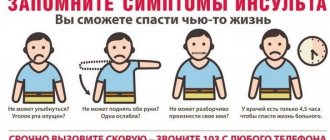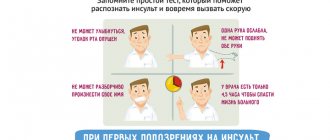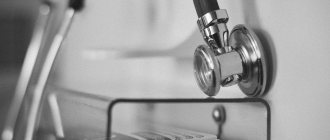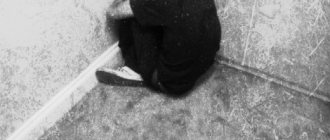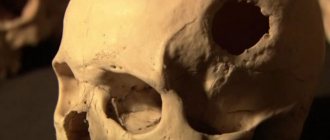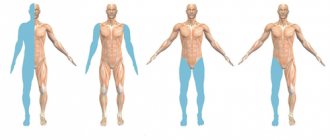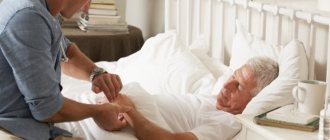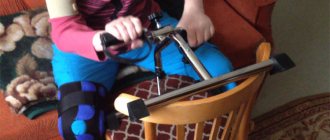Depending on the location of the affected area of the brain, a stroke may result in paralysis of the left or right side of the body.
As a rule, the most favorable option for recovery is the first option, when the left side is paralyzed. This is due to the fact that most vital organs (including the heart) are located on the left side of the body. Thus, if the left side is paralyzed, the function of the vital organs is not impaired, and the person can successfully recover, provided that certain rules are followed.
The first signs of a stroke
FIRST SIGNS OF STROKE
(for the population)
Shcherbonosova Tatyana Anatolyevna
Head of the Department of Nervous Diseases and Psychiatry,
KGBOU DPO Institute for Advanced Training of Healthcare Specialists
Gorbulina Svetlana Vladimirovna
Assistant at the Department of Nervous Diseases and Psychiatry,
KGBOU DPO Institute for Advanced Training of Healthcare Specialists
Stroke is a sudden disruption of blood circulation in the brain, blockage or rupture of a cerebral vessel. When a blood vessel is blocked, an ischemic stroke occurs, and when a blood vessel ruptures, a hemorrhagic stroke occurs.
It is considered to be the most common brain disease in the adult population. Moreover, with age, the risk of stroke increases significantly. According to statistics, stroke affects 0.1 - 0.4% of the population per year, depending on the country of residence.
Stroke is the leading cause of human disability and ranks third among the causes of mortality.
Scientific research has proven that stroke primarily affects men, but the female half of humanity also suffers a lot from this disease. Therefore, everyone must know the first signs of a stroke in order to provide timely assistance to a sick person, because delay in this case is unacceptable.
Stroke is an acute disorder of cerebral circulation
Even before the active development of a stroke, the patient may show signs of a transient cerebral circulatory disorder.
Precursors of stroke:
– a person experiences a sudden and inexplicable headache. It does not appear due to stress or any other explainable reasons;
– dizziness appears, coordination of movements or balance is lost;
– some part of the body may become numb: tongue, face, arm or leg, torso. This phenomenon is present on one side of the body - on the right or left and is accompanied by weakness;
– vision suddenly deteriorates. The patient becomes unable to see with both one and two eyes;
– consciousness and orientation in the environment are disrupted;
– there may be a speech disorder.
The sensations described above appear suddenly and disappear after a few minutes or hours. And if such attacks are repeated regularly, then a person develops a stroke of varying severity within a year. There is no need to wait for everything to end soon; you should immediately call an ambulance.
Before the ambulance arrives, you need to do the following:
- calm the patient down and put him to bed. It is advisable for him to turn his head to the side. If a person is agitated, constantly coax him to calm down. Until doctors arrive, he cannot be moved to another place;
– Place a towel soaked in cold water on the head of the stroke victim. An ice pack or any frozen food will do;
– measure blood pressure. If it is high, you need to give the patient a drug that lowers blood pressure, but the drug should be the one that the patient usually takes;
– create access of fresh air into the room. It is necessary to immediately remove the patient from a stuffy, especially smoky room. Be sure to open the windows, unbutton clothes that restrict breathing - you need as much air as possible.
To check that these are signs of a stroke, you can perform a simple test: ask to smile, if half of the face remains motionless, this is a stroke.
Ask to keep your arms raised, if the muscles are weak, this will not be possible, ask to repeat a simple phrase, if you cannot repeat after you, then there are problems with articulation and this is an acute attack of circulatory disorders.
Ask the tongue to stick out - its tip deviates towards the lesion in the brain if there is a stroke. If such symptoms occur, it is an ischemic stroke, the symptoms of which are unambiguous and suggest a cerebral circulatory disorder.
The sooner emergency medical care is provided, the more favorable the prognosis for such a serious illness will be. It is optimal if you seek help within 2-3 hours after the onset of the attack.
The difference between stroke and its causes in women and stroke in men.
Stroke affects women mainly after 60 years of age, while in men the risk appears after 40 years of age. Previously, it was believed that stroke was a problem for older people and that stroke affected women less frequently than men, and that after 60 years of age the risk was the same for both men and women. However, between the ages of 18 and 40, strokes began to occur more often in women than in men.
Pregnant women are also more likely to have a stroke. Young women often ignore the symptoms of transient ischemia. Women suffer strokes more severely than men. The mortality rate from stroke is higher in women than in men. A smaller percentage of women are able to return to their previous rhythm of life after a stroke; men cope better with this.
“Unconventional” early signs of stroke may be more common in women than in men. To the well-known risk factors in women are added: taking oral contraceptives, pathological pregnancy, migraine pain; women have a higher predisposition to thrombosis and vascular complications.
Women who have frequent mood swings, are not stress-resistant, are not balanced, and have a tendency to dwell on problems are more susceptible to cerebral stroke. Women who smoke after age 30 and take birth control have a 22 percent increased risk of stroke.
In recent decades, there have been very frequent cases of severe ischemic strokes associated with the popularity of such a method of contraception as oral contraceptives.
Signs of stroke in women.
Symptoms of the disease, both in women and men, will primarily depend on the part of the brain that is attacked by the disease. If the right side of the brain is affected, then the symptoms of the disease appear in the left half of the body and, conversely, if the left side of the brain is affected, changes are felt in the organs that are on the right.
The main symptoms of stroke in women are as follows:
– unbearable headache without good reason;
– the face begins to go numb, there is weakness of the facial muscles;
– the leg and arm go numb on one side of the body;
– the woman is unable to gesture;
– speech is impaired, the patient cannot say a word or speaks indistinctly, and she also cannot understand what is being said to her;
– vision is impaired, up to its loss, this is especially true for one eye. May see double;
– coordination of movements is impaired;
– there may be a sudden loss of balance, cramps appear in the legs, arms or other half of the body;
– the patient may fall, as unexplained dizziness appears;
– with a stroke, depression may develop and the woman cannot control her emotions – she cries or laughs for no reason;
– nausea appears, even vomiting, hiccups, temperature rises, swallowing functions are impaired;
– there may be loss of consciousness for a short period of time. Before this, the woman’s face becomes red, she begins to breathe frequently and deeply, her pulse drops, and her pupils stop responding to light.
Signs of stroke in men.
The main symptoms of the disease in males are almost the same as in women and include:
– unbearable sudden headache, which is accompanied by dizziness;
– a sharp weakness appears that cannot be explained by anything;
– the part of the body affected by the disease begins to go numb. If the stroke is left-sided, then pain and numbness are felt on the right side of the body, and if the disease affects the right side, then numbness and pain are present on the left;
– there may be visual impairment and speech disorder;
– very often there are convulsions, nausea leading to vomiting, increased body temperature, loss of consciousness and even coma.
Experts also identified atypical symptoms. These include dry mouth, chest pain, and mental disorders. Individually, they do not cause suspicion of apoplexy, but in combination with typical ones they provide serious reasons for immediately contacting a doctor.
Symptoms of hemorrhagic stroke in young people.
This disease affects not only older people; it also develops in young people. This is affected by the rupture of a cerebral vessel aneurysm; this phenomenon is most often observed at a young age.
A hemorrhage occurs in the lining of the brain and a headache appears so severe that the person screams from unbearable pain. Then vomiting and loss of consciousness begin, but then the patient regains consciousness.
Such patients feel constant drowsiness and lethargy, which does not leave them for several days in a row, with a severe headache, vomiting is possible, but there is no paralysis.
Proper nutrition and a healthy lifestyle can help prevent strokes
Not a single person on the planet is immune from terrible diseases or premature death. But everyone has the opportunity to prevent disaster. In the case of stroke in women, especially young women, experts recommend adhering to the following recommendations. Some of these helpful tips will help prevent stroke not only in women, but also in men of any age:
– reduce the consumption of salty and fatty foods;
– refrain from smoking and simultaneously taking hormonal contraceptives;
– in case of diabetes mellitus, it is necessary to carefully monitor blood sugar levels;
– do not abuse alcohol and energy drinks;
– play sports or do exercises daily;
- monitor your sleep patterns - lack of sleep can also lead to impaired blood circulation in the vessels of the brain;
– monitor your weight – extra pounds push the body towards many diseases;
– eat more fruits and drink more clean water.
Fragment of the article “Lie down or be treated”,
"Russian newspaper"
dated April 23, 2020, No. 86 (6657)
Source: https://zdrav.khv.gov.ru/node/3884
Numbness of the hands after a stroke: symptoms and treatment
In the modern world, stroke occurs in almost every person over 50 years of age. The disease is mainly diagnosed by the degree to which movement of the paralyzed part of the body is reduced. Patients exhibit left- or right-sided numbness of the facial muscles, and swallowing is impaired.
If, after a stroke, symptoms such as distortion of facial features, the inability to raise both arms at the same time, pronounced tremors in the limbs, or difficulty smiling are revealed, then immediately call an ambulance.
Recovery periods
Rehabilitation for stroke patients necessarily takes place in several stages. This is the use of various drugs that help break down growths on the walls of blood vessels and improve blood circulation in the cerebral hemispheres. Also included are various types of exercises used to restore movement and increase sensitivity in the right or left hand.
Physical rehabilitation after a stroke includes the following stages:
- Ask the patient to mentally, with his eyes closed, imagine the state before the illness, try to think about those movements that were previously performed with his hands without problems. The patient will try to move his fingers, then his hand, and learn to bend, straighten and raise his arms.
- Make sure that the victim performs the exercises as accurately as possible.
- The course of exercises can be periodically replaced with more complex ones, depending on the dynamics of improvement in joint mobility. Classes should be designed not only to develop the elbow joint, but also the wrist of the paralyzed hand.
- Exercises during the day should be regular, especially on the paresis side.
- Make sure that the patient tries to work mainly with the hand that does not work well after a stroke. By shifting everything to the healthy hand, he will not learn to move both hands.
Useful exercises for a person who has suffered a stroke include the use of homemade exercise equipment. A hand exercise bike, elastic belts with handrails, and exercises with rubber balls can help get rid of numbness in your arms and legs.
To enhance the effect, together with all physical warm-ups, doctors recommend performing a rubbing massage of the limbs for several minutes every day. Additionally, electrical stimulation, as well as physiotherapeutic procedures, depending on the type of developing consequences.
Signs of a stroke
During a transient ischemic attack, the signs leading to a stroke are periodic, tremors and numbness occur, trembling in the upper and lower extremities, accompanied by severe pain in the head. After a stroke, the duration of symptoms gradually increases.
The following sensations arise:
- Slowly increasing numbness in the arms and legs.
- Speech function disorder.
- Tremor on the side of the paresis.
- Double images, loss of visual fields.
- Excessive sweating, redness of the facial skin.
- Violation of thought processes.
These symptoms may persist even after hospitalization for a month. This is influenced by the depth and extent of the brain stroke focus.
Reasons for decreased mobility
Sharp tremor and numbness in the body alarm everyone, especially if it concerns loved ones. Such reasons may be associated with the occurrence of a transient ischemic attack or the onset of an ischemic stroke, which the doctor determines by the following signs:
- Atherosclerosis of the cerebral arteries.
- Formation of blood clots in the bloodstream of the heart.
- Dilatation of the veins of the lower extremities, there is a possibility of fragmentation; separated growths on the blood vessels can enter the general bloodstream, preventing blood from moving normally along the vascular bed.
- Postoperative intervention in the area of the carotid artery or injuries of the cervical spine, as well as due to osteochondrosis.
- Instability in blood pressure readings.
- High thrombus formation.
The role of exercise therapy classes
As a result of a stroke, the consequences can be unpredictable. During this very period, not only speech disturbances and decreased mental functions can be observed, but also tremors during movements. There is no likelihood that the patient, without receiving additional help, will be able to independently restore the functions he lost before the illness.
Therefore, during treatment, the use of drugs to reduce coagulation, control blood pressure, including physical exercises that improve the mobility of the joints of the arms and legs, becomes important for many patients. Do not begin exercises without consulting a physical therapist. After all, tremors and numbness in the hands manifest themselves differently in everyone.
After a stroke, the victim may feel his left or right hand shaking for a long time. Including slight numbness in the hands and tremors in the legs when moving.
To reduce paresis on the paralyzed side of the body, exercises are not contraindicated for patients in a coma. They should not be too intense, but take place in a more passive form. Exercise helps eliminate bedsores and atrophy of the lower extremities.
Rehabilitation
A person after a stroke needs constant help from the medical team and loved ones.
Knowing the characteristics of the course of a stroke, start with the simplest and most uncomplicated activities. For example, flexion and extension of the arms and legs at the joints up, down, counterclockwise, and in the opposite direction.
It is worth considering that if there is excessive numbness of the hands, accompanied by pain when moving, then physical exercise should be reduced or changed to less active ones.
It is necessary to constantly praise the victim for the task he performed, even minor movements of the fingers.
After restoring some movements, one should not assume that the patient will independently perform the exercises indicated to him.
Therefore, in order for the numbness of the hands to begin to be felt in a less pronounced form, the patient must perform any exercises within his power every day during the subsequent years of rehabilitation.
Traditional methods
No treatment method can lead to a 100% guarantee that paresis will be cured and subsequently recur. Therefore, it is worth remembering that there will always be consequences.
First of all, when prescribing medications, doctors may recommend rubbing an infusion of 2 tbsp to increase sensitivity. l laurel with vegetable oil. Tremor and numbness in the body, arms and legs after such a procedure are expressed to a lesser extent.
If you drink linden tincture before eating, you can prevent paresis and increase the restoration of movements in the arms and legs.
A mixture of medicinal herbs Adonis vernacular, Cinquefoil anserina and common thyme helps reduce paresis and help restore blood flow in the affected limbs.
Unrefined oil and garlic infused with an oil base, when taken three times a day, 10 ml of the drug within 24 hours, helps eliminate many of the consequences of a stroke. It is also useful for restoring movements due to the cleansing properties of garlic cloves.
Traditional medicine
Numbness after a stroke leads to periodic tremors. If pathology is detected on the left side of the head, then the right leg and arm are paralyzed. And vice versa.
To save the patient, the doctor prescribes anticonvulsants, for example, Finlepsin or Carbamazepine 200 mg per day.
It is important to be careful: you should not allow the dose of Finlepsin to increase; there is a danger of causing bone fragility due to leaching of calcium from the body. The drug Carbamazepine is addictive, if there is little benefit and the doctor may write a prescription for Topiramate, Levitaratsitam or Gabapentin instead of this medicine.
Loading…
Source: https://medded.ru/zdorove/golovnoj-mozg/vosstanovlenie-dvizheniya-ruk-posle-insulta
Arms and legs go numb: reasons and what to do. Signs of stroke and heart attack
Numbness of a limb is when an arm or leg becomes “woolly”, sensitivity is lost, or it burns and tingles as if with many small needles.
This often happens when peripheral nerves are compressed, say, if you “sit out” your leg or “lay down” your arm in your sleep. Numbness usually passes quickly and is not accompanied by other alarming symptoms.
Less commonly, numb limbs can indicate problems and illnesses, from a lack of B vitamins and folic acid to diabetes, multiple sclerosis or a brain tumor. But in these cases there must be other serious symptoms.
When is numbness a sign of a stroke?
Many people are scared that numbness is considered one of the first signs of a stroke. But in order not to panic in vain, remember: numbness in itself, without other signs, usually does not indicate a serious threat to health and life.
With a stroke, numbness occurs in any part of the body, but only on one side, and is certainly accompanied by some of these symptoms:
- weakness, dizziness, headache;
- loss of coordination, balance;
- nausea;
- speech disorder;
- facial distortion;
- blurred vision;
- disturbance of consciousness, orientation.
In detail: What is a stroke. How to recognize the signs
Numb arms/legs: reasons, what to do
1. The most obvious reasons are that the vessels are “pinched,” temporarily disrupting blood circulation, or the nerve fibers are “pinched.” For example, if you held your hand in one position for a long time (“got numb” in your sleep, your hand is constantly on the computer mouse, etc.).
In this case, it’s enough to just stretch and crush the limb so that everything is restored.
2. If your arms or legs go numb without obvious reasons and regularly, then most often this is due to peripheral neuropathy - damage to the nerve fibers leading to the extremities. It itself can be caused by diseases, which are most often associated with metabolic disorders and glandular dysfunction.
According to neurologists, the most common causes of such neuropathies are diabetes and alcoholism . In most cases, the legs become numb.
Shutterstock
3. In more rare cases, limbs may become numb due to injuries, physical overload, cervical arthritis, or a vertebral hernia that compresses the nerve.
What to do in this case depends on the reason. Sometimes resting and allowing the injury to heal is enough. With a cervical hernia, rest also helps, and discomfort is relieved with warm and cool compresses and pain relievers. Cervical arthritis is relieved by a medical cervical collar (brace) and physical therapy.
But if the numbness does not go away, then you need to see a doctor. Prescription medications or surgery may be needed.
4. Finally, arms and legs may go numb due to more serious diseases, such as multiple sclerosis, tumors, autoimmune, and hereditary diseases.
These cases usually present with other noticeable symptoms, ranging from muscle weakness, dizziness and nausea to loss of coordination, pain and even paralysis. Only doctors will help here.
Depositphotos
What if your fingers go numb?
Fingers may go numb separately with the same peripheral neuropathy, depending on which nerves are damaged.
If it is radial, then the thumb and index finger may become numb; if it is ulnar, then the thumb and half of the ring finger, etc.
Meanwhile, compression of the median nerve causes a disease called carpal tunnel syndrome, also known as carpal tunnel syndrome. It also manifests itself as pain and numbness in the fingers and is often found in those who hold their hands in one position for a long time: from gamers to pianists and cyclists.
Depositphotos
If your left arm goes numb: signs of a heart attack
As with a stroke, just a numb arm does not mean a person is about to have a heart attack. Therefore, if there are no other alarming symptoms, do not panic.
But immediately call an ambulance if, in addition to numbness in your left arm from the shoulder to the elbow or to the little finger, there are the following signs:
- severe pressing pain in the sternum;
- pain radiates to the arm, shoulder (or both shoulders), neck, jaw, back, coming in attacks;
- the body is covered in cold sweat;
- you feel severe weakness, lack of air;
- it seems that you have been poisoned (stomach pain, nausea, vomiting).
Source: https://www.anews.com/p/119843794-nemeyut-ruki-nogi-prichiny-i-chto-delat-priznaki-insulta-i-infarkta/
Diagnostics
At the first symptoms and signs of a spinal stroke, it is necessary to diagnose using the following research methods:
- Neurological and visual examination of the patient.
- Carrying out magnetic resonance and computed tomography of the spinal cord.
- X-ray examination of the spinal column.
- General blood test.
- Puncture for the purpose of collecting and further cytological examination of fluid from the spinal space.
- Blood test for coagulation indicators.
- Rheoencephalography.
- Electroneuromyography.
- Ultrasound Dopplerography.
All these research methods help to establish the presence of disorders in the spinal cord and prescribe correct and timely therapy. Symptoms and treatment of spinal stroke are interrelated.
Numbness of the hands during and after a stroke
There are many reasons for numbness in the hands - from a lack of vitamins and problems in the spine to a stroke. In this article we will look at the symptom of hand numbness due to cerebral ischemia. We will learn how to recognize the first signs of a stroke (cerebrovascular accident) and what should be done. Let's consider the types of cerebral ischemia and the treatment regimen.
Paresthesia is a sensory disorder characterized by a feeling of numbness and a crawling sensation.
Causes of hand sensitivity disorder
Numbness of the hands (paresthesia) is one of the symptoms of stroke (cerebrovascular accident). Impaired sensitivity of the limbs on one side of the body is accompanied by other focal, cerebral and autonomic symptoms.
The cause of numbness in the hands after a stroke at a young age is inflammation of the vascular wall or blockage by a blood clot. In older age, hand numbness after a stroke is more often associated with atherosclerosis, arterial hypertension, diabetes mellitus, abdominal obesity, and smoking.
Risk factors for stroke and hand paresthesia are smoking and alcohol. The genetic background for the development of cerebral ischemia is a predisposition to strokes in relatives.
Numbness of the hands after a stroke: causes, treatment
There are many reasons for numbness in the hands - from a lack of vitamins and problems in the spine to a stroke. In this article we will look at the symptom of hand numbness due to cerebral ischemia. We will learn how to recognize the first signs of a stroke (cerebrovascular accident) and what should be done. Let's consider the types of cerebral ischemia and the treatment regimen.
Paresthesia is a sensory disorder characterized by a feeling of numbness and a crawling sensation.
Description
What are the symptoms of a spinal stroke? The disease is characterized by a disorder that occurs during the blood circulation of the spinal cord. The pathological process can be presented in the form of ischemic, hemorrhagic and mixed stroke. With any type of disease, active death of white and gray matter occurs, as well as death of tissues and neurons.
During normal functioning of the body, blood is delivered through the anterior and posterior arteries of the spinal cord in the required volume. The anterior artery supplies nutrition to the cervical and thoracic spine in its upper part, and the posterior artery is responsible for the blood supply to the sacrococcygeal and thoracic spine in its lower part.
The arteries of the spinal cord merge with the radicular vessels and transform into the radicular-spinal arteries. They, in turn, ensure the delivery of oxygen and various nutrients to the spinal cells. The largest vessel in this system is located in the lumbar spine. When the blood supply is disrupted, severe damage to the spinal cord occurs. This process is accompanied by characteristic signs.

